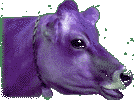
|
Did You Know...
|

|
The average cow weighs 1,200 lbs. (544.8 kg) and has a life span (if left alone) of 18 years, but 25-30 are possible.

|

|
Cows provide many different products for people, like food, clothing, pet food and fertilizer. Did you know the word "cow" only refers to the grown up female animals? A more precise word is "cattle", which means many different kinds, regardless of whether they're beef or dairy, male or female, young or old.

|

|
When a cow is two years old, she will have her first calf. Her udder then makes milk to feed the baby. Some breeds, such as the black and white Holstein and the tan Jersey, produce so much milk that humans are able to use what the baby doesn't finish.

|

|
All cattle have lots of muscle, which is the beef we eat in hamburger, hot dogs and other good foods. Two popular cattle breeds that are bred for beef are the red and white Hereford and the all-black Angus.

|

|
When you visit Hard Bargain Farm, you will meet about thirty cattle. One Jersey dairy cow, Penny and one is our Angus bull Sir Loin. The rest are Hereford cows and calves.
|


Here is some background on things that are consumed by cattle.
|

|
Air - Cows are like all animals. They need to breath fresh air with plenty of oxygen.
|

|
Water - A heavy producing dairy cow may drink as much as 35 gal. (132.5 liters) of water daily in addition to moisture in her feed, silage, or grass.
|

|
Grass - A cow grazes by curling her tongue around the grass and cutting it off with her lower teeth and a slight upward movement of her head. She will eat about 100 lbs. (45 kg) of grass a day.
|

|
Hay - The average cow can eat about 35 lbs. of good hay a day when grass is not available.
|

|
 Grain - Corn, soybeans, wheat, barley or oats in any mixture are ground up and moistened with molasses to keep down the dust.
Grain - Corn, soybeans, wheat, barley or oats in any mixture are ground up and moistened with molasses to keep down the dust.
|

|
Vegetables and Fruit - Cattle eat kale, cabbage, potatoes (white and sweet), apples, rutabagas, beets (and their tops), turnips, carrots, broccoli, pea vines, bean stalks, pumpkins and squash.
|

|
Additional minerals and salt - Additional minerals and salt come in the form of a salt block that cows lick or granules that are added to the cow's grain mixture.
|
|


Here is some background on things that are produced by cattle.
|

|
Urine - The average cow produces 3.5 gal. (13.2 liters) daily.
|

|
Manure - A cow produces 65 lbs. (29.5 kg) of feces or manure daily - that's 12 tons (908 kg) a year. A cow can poop up to 15 times a day.
|

|
Heat - The body temperature of a cow is 101.5 degrees Farenheit (38.6 degrees Celsius).
|

|
Milk - Female cows produce an average of 8 gallons (30.1 liters) per day, but may range from 4 to 20 gallons (15.1-7.5 liters). A gallon of milk weighs 8.6 lbs. In 1880 the average cow produced 2,003 lbs. (909 kg)of milk per year. In 1982 the average cow produced 12,316 lbs. (5,591 kg) of milk per year.
|

|
Meat - The average American eats about 110 lbs. 50 kg) of beef per year. On average, a 900 lb. (408 kg) steer produces about 450 lbs. (204 kg) of meat (or 50% of its body weight).
|

|
Bonemeal - After cows are slaughtered, their bones may be dried and ground for use as a calcium source in poultry or other livestock feed, or as a fertilizer.
|

|
Leather - Leather is the tanned hide (skin) of an animal. A cow's hide makes good leatherfor shoes, belts, coats and upholstery because it's so thick.
|

|
Cheese - The average American eats 1,000 lbs. (454 kg) of cheese in a lifetime. It takes 10 lbs. (4.5 kg) of whole milk to make 1 lb. (0.454 kg) of cheese.
|
|









 Grain - Corn, soybeans, wheat, barley or oats in any mixture are ground up and moistened with molasses to keep down the dust.
Grain - Corn, soybeans, wheat, barley or oats in any mixture are ground up and moistened with molasses to keep down the dust.



